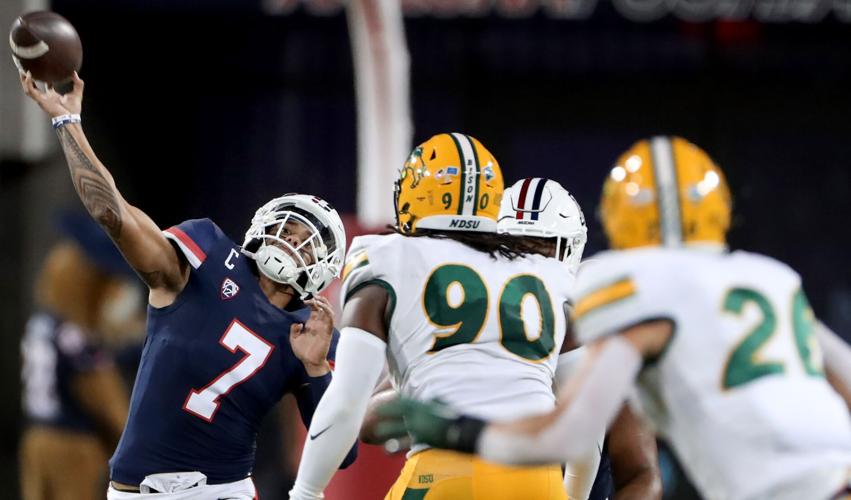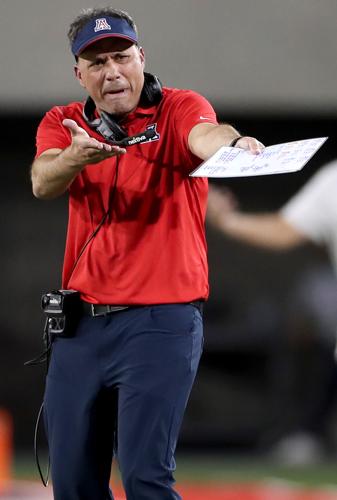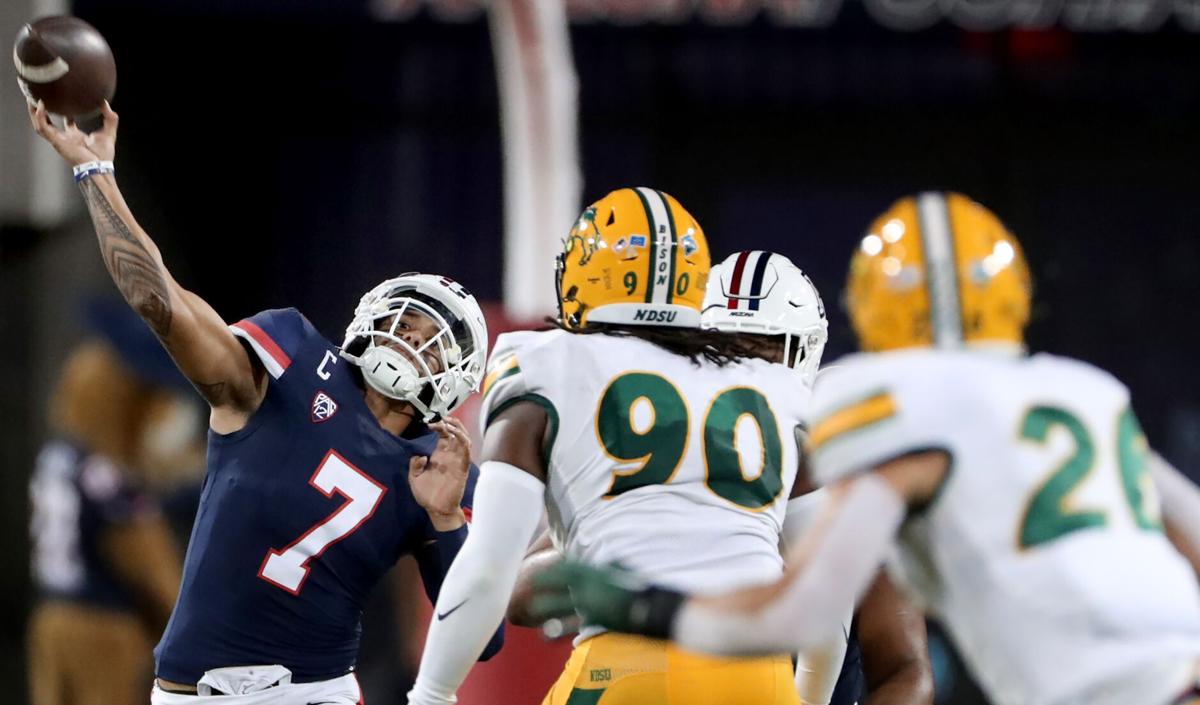The Arizona defense hasn’t played well of late, and the forecast isn’t favorable: Upcoming opponents USC, Utah and UCLA all average more than 40 points per game.
Wildcats coach Jedd Fisch wants to improve defensively, of course. But he’s also a realist — and the man who runs the team’s offense. So his short-term solution to Arizona’s defensive woes is to ... score more points.
In reviewing last week’s 49-39 loss at Washington, Fisch remarked: “Looking back at the game, I think that it was what we expected it was gonna be for the most part. ... Just didn’t score enough points. Seems like right now that’s what the Pac-12 is about.
“We’ve got some great offenses right now. The Pac-12 is about scoring and quarterbacks. We’re very fortunate to have the one we have. We’ve got to find a way to score a few more points than the next team.”
Fisch’s words weren’t so much a concession as an acknowledgement: Offenses have struck back in the Pac-12. Scoring is up. If you can’t keep up, you’ll probably lose.
In this bye-week edition of “Cats Stats,” we’ll examine those numbers, explore what’s behind them and determine what it all means for the Wildcats.
Let’s start with Fisch’s thesis, which he extended to include all of college football: Are offenses truly having their way, or does it just seem like it?
Scoring is up across FBS, but only slightly. Teams averaged 28.5 points per game in 2021. They’re averaging 29.7 points this year.
The Pac-12 is a different story. Collectively, Pac-12 teams are averaging 5.4 more points per game. Eight of the 12 teams have a higher scoring average this year than last year. Cal is about even (23.7 vs. 23.8). Only Arizona State (down 1.6 points), Washington State (3.2) and Colorado (4.3) are scoring noticeably fewer points.
Four Pac-12 schools are scoring at least 10 more points per game than last season: Washington (20.6), Arizona (14.7), USC (11.7) and Oregon (10.6).
In Pac-12 play, three of those schools have increased their scoring output by at least two touchdowns: Washington (18.8 points), Arizona (16.3) and Oregon (14.4). Eight of 12 teams have a higher scoring average in conference games than last season. Overall, scoring in Pac-12 games is up by an average of 4.2 points per team.
As Fisch noted, it’s hard to find Pac-12 teams in the top 50 nationally in total defense (yards allowed per game). Currently there are three: UCLA, Utah and Oregon State. The Bruins are the highest ranked at No. 33. The Beavers barely make it at No. 50.
Five Pac-12 schools rank in the top 50 in scoring defense (points allowed per game): Washington State, Cal, USC, Utah and UCLA. But that’s mainly a byproduct of beating up on out-of-conference opponents. Teams are allowing four more points per game in Pac-12 play (31.2) than their overall average (27.2).
In terms of total offense, the Pac-12 has six teams in the top 50 – and they’re all in the top 25: Oregon, Washington, UCLA, USC, Utah and Arizona.
Fives of those six — Arizona being the exception — also rank in the top 25 nationally in points per game. Only two (UCLA, Utah) ranked in the top 40 at the end of last season.

So what’s changed? A lot. The four schools that have increased their scoring outputs by at least 10 points per game have new coaches, new quarterbacks or both.
Washington and USC hired offensive-minded coaches in Kalen DeBoer and Lincoln Riley. They brought in quarterbacks with whom they had backgrounds: Michael Penix Jr. and Caleb Williams. The Trojans also added a ton of high-end skill-position talent through the transfer portal.
Arizona has a new QB in Jayden de Laura and a mostly new pass-catching corps. As Fisch pointed out, not one player who recorded a stat on offense vs. Washington last year made the box score this year.
Oregon hired a defensive-minded coach in Dan Lanning. But his offensive coordinator, Kenny Dillingham, previously worked with transfer QB Bo Nix.
It’s no coincidence that those teams have made huge leaps on offense. UCLA and Utah have made slight gains – averaging 4.8 and 4.6 more points per game, respectively – thanks to continuity and experience. The Bruins’ Dorian Thompson-Robinson was the second-team All-Pac-12 quarterback last year. The Utes’ Cameron Rising was the first-team honoree. They’re playing for the same coaches in the same systems as a year ago.
Fisch cited several other factors that favor offenses, including the space that’s available in college football because of how far apart the hashmarks are; the growing number of elite athletes who are now playing quarterback; and the reduction in tackling during preseason and in-season practices.
“It’s certainly making it fun if you’re calling plays on offense,” Fisch said. “And making it challenging if you’re calling plays on defense.”
He added this:
“But that’s no excuse. We’re going to do everything we can to become a much better defensive football team.”
For the rest of this season, it’s about managing expectations.
Embattled defensive coordinator Johnny Nansen — is it too early to call him embattled? — is likely to play more young players down the stretch, for better or worse. He could make some schematic tweaks, but it’s unlikely that he’ll make any significant changes this late in the season, even with the benefit of a bye.

Jedd Fisch knows scoring is up in the Pac-12, and the Wildcats likely need to increase their offensive output to keep pace in the second half of the season.
The Wildcats gave up 49 points, on the nose, against Cal, Oregon and Washington. Can they cut that down by 10 against USC, Utah and UCLA – which would mean holding all three under their current averages?
That could be enough to steal a win before Arizona closes the season against WSU and ASU — two of the five Pac-12 schools that are scoring less than 30 points per game.
Of course, Cal is one of them as well, and you know what happened in Berkeley. The Golden Bears haven’t scored more than 20 points in any of their other four games vs. FBS opponents.
The other results, in the context of the offensive explosion in the Pac-12, are at least understandable. That one remains confounding.







